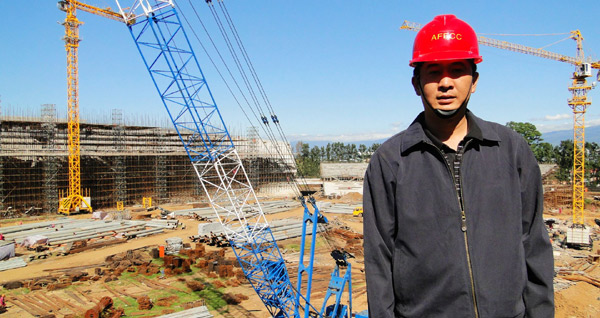Workers building recognition for China
Updated: 2010-12-21 08:31
By Wang Di (China Daily)
|
|||||||||||
Beijing - When a list of the top newsmakers of the year was announced on the other side of the world in Costa Rica, sitting securely on the list was none other than a Chinese.
Or more precisely, a team of Chinese.
|
 Cai Lin, manager of a group of Chinese workers helping build the Costa Rica National Stadium, stands in front of the construction site in this file photo taken on Dec 9, 2009. [Provided to China Daily] |
Cai Lin, manager of a group of Chinese workers helping build the Costa Rica National Stadium, said such recognition couldn't have happened when they arrived two years ago in the Central American country, where the only impression people had of Chinese were businessmen immigrating from Taiwan or Guangdong.
"Local people doubted whether we could complete the construction on time with only about 300 workers at the start of the project," Cai said. "But they are now overwhelmingly impressed by our construction speed."
The national stadium, co-built with Chinese assistance of $83 million, is expected to be the largest in Central America with a capacity of 35,000, athletic track lanes and a sports museum.
Cai and his team, employed by Anhui Foreign Economic Construction (Group) Co Ltd, began construction in March 2009 and completed four months ahead of schedule in November 2010.
"It's a challenging task to finish such a huge construction project in 20 months, even in China, not to mention in Costa Rica which has a long rainy season," said Cai. "But we must complete the task because we are building in Costa Rica and the local people's impressions of Chinese come from us."
Building in the rainy season - which lasts for seven months a year in Costa Rica - was the greatest challenge to the builders, most of whom are in their 30s with experience of building in African countries.
Under the pressure of a deadline, workers continued working in rain-soaked clothing and sloshing around in puddles.
The construction site looked like a battlefield with machinery roaring and the Chinese workers like ants covered in mud, a Costa Rican newspaper reported.
Engineer Zeng Haitao could feel the change in local people's attitudes when he was greeted with thumb-ups on his way to the site.
"We just want to tell people that 'China Made' not only has Chinese speed, but more importantly has a reputation of quality," Zeng said.
Zeng is proud of his team and credits Cai for his charisma and solidarity.
The team usually takes its own machinery when it builds abroad, and often works overtime to meet a deadline.
To get around the different cuisine in Coast Rica, the workers brought seeds from China and grew vegetables like peppers, cabbage and lettuce in the land near their camp, so they still cook typical Chinese food like scrambled eggs with tomato.
Cai and his workers also took laptops. Eighty-five percent of them have their own laptops and use the wireless network at the camp for entertainment - and more importantly as the main means to contact families back home.
Despite staying in Central America's most-visited country for nearly two years, the team hasn't traveled around much or had much interaction with local people because of the language barrier.
Nevertheless, the project has attracted the attention of the public, who love sports and cannot wait to have a close look at the modern building.
College students from the University of Costa Rica have seen this as a good opportunity to learn construction techniques from Chinese engineers - more than 20 architecture students led by their professors came to the construction site each week and studied for seven months.
"We can feel the construction speed and it will be a generous gift given by the Chinese people to the Costa Rican people, who love sports," Former Costa Rican president Oscar Arias said during a visit to the stadium in September 2009.
Though the workers have become used to their surroundings, their two years in Costa Rica will soon end.
"The stadium is just like our child and we feel happy that it has grown into the largest and most beautiful in Costa Rica," said Zeng.











